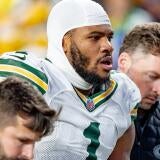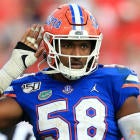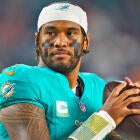What the Texans didn't do in the 2020 NFL Draft, and one thing they definitely got right
Houston still has one gaping hole on their roster
Before the draft, we mapped out how the Texans could pull off the perfect 2020 NFL Draft. Houston, fresh off of a second-round appearance in the AFC playoffs, followed most of our advice while filling several holes on their roster. As advised, the Texans addressed the trenches, selecting TCU defensive end Ross Blacklock with the 40th pick and North Carolina offensive tackle Charlie Heck in the fourth round. Houston also acquired a formidable pass rusher in Florida's Jonathan Greenard, with the 90th pick. The Texans were also able to add to their secondary, selecting Penn State cornerback John Reid. With the exception of Heck, Houston's draft picks received high marks from CBS Sports NFL draft analyst Chris Trapasso.
That being said, the Texans failed to properly address three positions of need entering the draft. Let's take a look at each position and what Houston can still do to address these needs before the start of the 2020 season.
1. Add more depth at wide receiver
I know the Texans used their final draft pick on Rhode Island receiver Isaiah Coulter, a 6-foot-3, 190-pound target that caught eight touchdown passes last season while averaging 14.4 yards per catch. I'm also aware that Houston acquired Brandin Cooks, a former first-round pick, and Randall Cobb earlier this offseason. And while each of these players should help the Texans' passing attack overcome the loss of DeAndre Hopkins, Houston needs to do even more to help shoulder the loss of arguably the NFL's best receiver.
Houston did sign undrafted rookie receiver Tyler Simmons, a 6-foot, 201-pound target that caught 35 passes and three touchdowns in four seasons at Georgia. The Texans should consider looking into the possibility of signing Antonio Brown, assuming he is eligible to play when the NFL begins the 2020 season. While he definitely has his baggage, Brown, who is surely looking to make the most of what could be his final opportunity in the NFL, would give Deshaun Watson an elite playmaker at the receiver position.
2. Add more depth at running back
While David Johnson and Duke Johnson are a good 1-2 combo in the backfield, Johnson has not been the same since missing most of the 2017 season with an injury. Given Johnson's question marks, and with Hopkins no longer in the fold, the Texans should have acquired one of the draft's top running backs to give them an added dimension -- along with an insurance policy at the running back position -- during the draft. Johnathan Taylor, one of the top running back prospects entering the draft, were both on the board when the Texans selected Blacklock with the 40th pick. Taylor was then immediately selected by the Colts, who traded up to take him with the 41st pick.
After the draft, the Texans signed undrafted rookie Scottie Phillips, a 5-foot-8, 211-pound running back who rushed for 17 touchdowns while averaging 5.3 yards per carry in two seasons at Ole Miss. The Texans should also take advantage of a deep running back free agent market that includes Devonta Freeman, Lamar Miller, Chris Thompson, LeSean McCoy, and Frank Gore.
3. Use free agency to address safety
Despite their needs at this position, the Texans failed to select a single safety during the draft. Houston passed on a safety despite top prospects Grant Delpit, Antoine Winfield Jr. and Jeremy Chinn being available when the Texans were on the clock with the 40th pick.
Houston has also not signed any undrafted safeties in the days following the draft. And while the talent pool isn't terribly deep, the Texans do have some safety options in free agency that includes Reshad Jones, Tony Jefferson, Eric Reed, Morgan Burnett, Tavon Wilson and Antoine Bethea.
4. Take a chance on a free agent tight end
While they did not select a tight end during the draft, Houston did pick up former James Madison tight end Dylan Stapleton as an undrafted rookie. The 6-foot-5, 242-pound Stapleton, a second-team all-conference performer last season, caught a season-best six passes for 66 yards against North Dakota State in the national championship game.
Unfortunately for the Texans, the current market at the tight end position is considerably bare. The team may decide to take a chance on Jordan Reed, a former Pro Bowler in Washington whose history with head injuries has put his career in jeopardy. Delanie Walker, a three-time Pro Bowler who will turn 36 in August, is another free agent option.


















